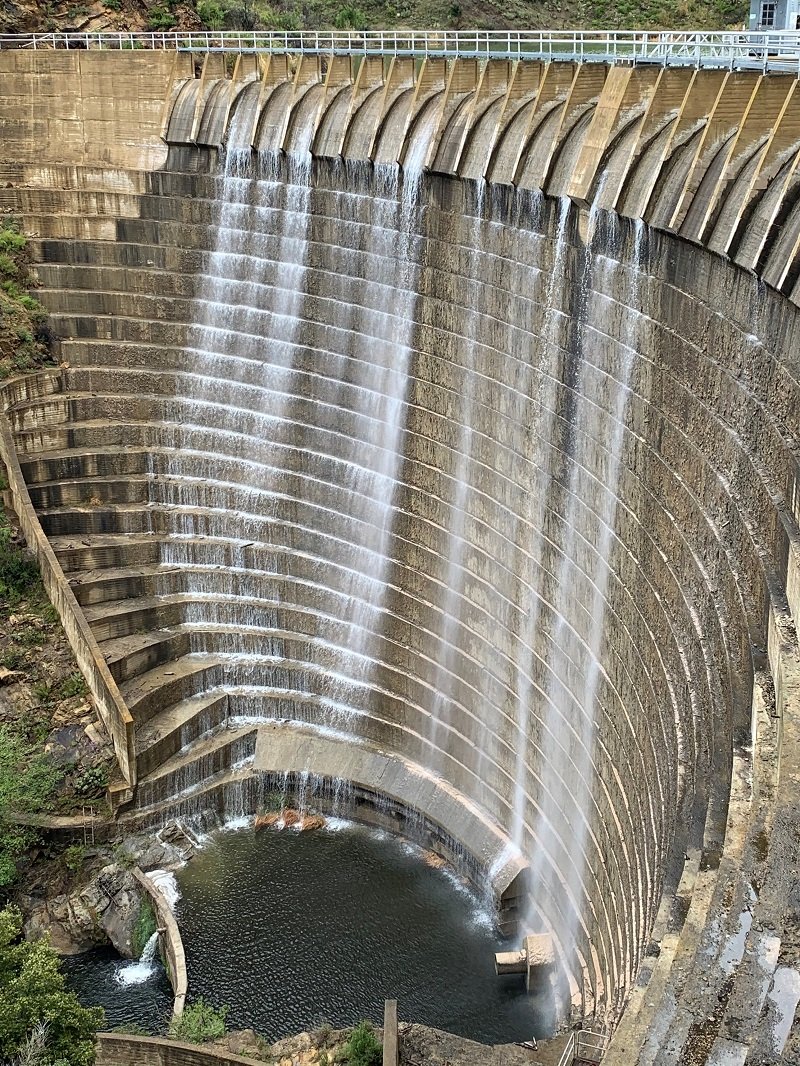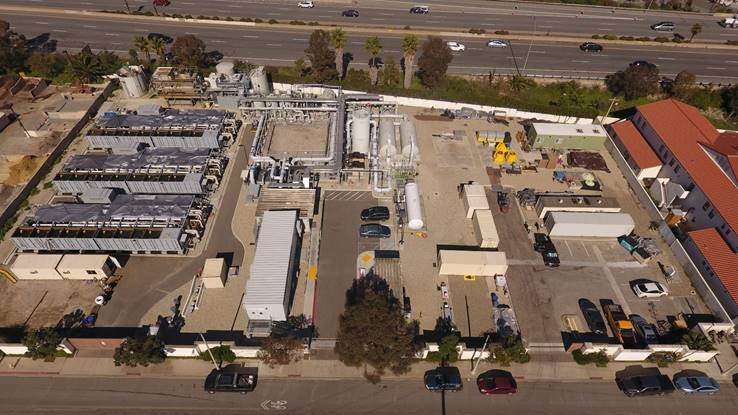Montecito Water District Board nears vote to purchase yearly water supply from Santa Barbara



MONTECITO, Calif. - Promising to “drought-proof” Montecito and banish rationing – if not forever, at least for the foreseeable future – the Montecito Water District board on Thursday is poised to approve the purchase of a multi-million-dollar supply of water from the City of Santa Barbara, every year for the next 50 years; and sign off on a five-year schedule of rate increases to help pay for it.
Under the proposed “Water Supply Agreement” with Santa Barbara, which is six years in the making, the district’s 11,400 ratepayers, primarily in Montecito but also in Summerland and Toro Canyon, would effectively fund 46 percent, or $33 million, of the city’s $72 million desalination plant over 50 years, plus interest and a share of the plant’s operation and maintenance costs.
In return, the city would guarantee a supply of 1,430 acre-feet of drinking water to Montecito Water District customers, year in and year out, through 2071. That’s 46 percent of the current desalination supply, and it’s enough to meet 40 percent of the district’s customer demand.
“If it were up to me, I’d sign up for 100 years,” said board President Floyd Wicks, who was elected in 2016, when Montecito residents faced per-parcel caps on water use and stiff fines for over-watering. “The community needs to have a plan in place that provides for a reliable water supply that’s predictable in cost. We haven’t had that for a long time.”
Not since county voters approved bonds for the construction of a state aqueduct branch to Lake Cachuma in 1991 has a water vote had such import for Montecito.
Once again, the vote comes on the heels of a severe drought.
Under rationing from 2014 to 2017, Montecito, a wealthy community of one-acre lots, big estates and luxury hotels and golf courses, cut its water use by 50 percent. At the same time, between five and 10 percent of district customers regularly paid the fines instead of cutting back: they included the San Ysidro Ranch; the Biltmore; and Ty Warner, their billionaire owner, at his tropically-landscaped estate on Channel Drive.
“Those penalties were really a thorn in the flesh for many people, and for our new board,” Wicks said. “I don’t want to go through it again. People made some very serious long-term changes to their irrigation habits. I don’t see how the community can do much better than what they already did.”
“On a mission”
The annual bill for the Santa Barbara supply would be about $4.6 million through 2038, at which time Montecito’s share of the capital cost of the desalination plant would be paid off. For the remaining 33 years, the district’s annual bill would drop to $2.3 million. Rain or shine, the supply would be delivered and the bills would be due.
To help pay for the water, the board proposes to raise district revenues by 2.8 percent per year for the next five years by raising rates and meter service charges. As is the case now, higher water users would pay higher rates. The Aug. 1 bill would reflect the new changes.
Under the agreement, Santa Barbara would retain full ownership of its desalination plant. It provides the surplus that is available for sale to Montecito; but the city would be able to send water from any source to its next-door neighbor.
“The whole strategy has been, ‘How do we increase reliability?’” said board Director Tobe Plough. “We campaigned on it. What we said we were going to do is what we’ve been working on.”
But several prominent board critics, including Bob Roebuck, a former general manager of the district; Charles Newman, a Montecito planning commissioner; and Dick Shaikewitz, a 12-year water board veteran who was voted out in 2018, contend that the district’s plan is unreasonable. Conservation, these critics say, is a better alternative than locking ratepayers into a 50-year debt for landscaping water that, most years, they won’t need, even in a community where the median household income is nearly $150,000.
“It’s crazy,” Roebuck said. “The board’s on a mission. The average customer lives within their means, but there’s a group of customers who just want to have all the water they can possibly use during the worst year of the worst drought, and they want everyone to pay for it. I’m sort of despondent about the whole thing.”
Newman, who lost his seat on the water board in 2016, believes the district should set its sights on a supply of wastewater that can be treated to drinking standards, a technology, formerly called “toilet-to-tap,” that is still a few years away. Newman worries that sea level rise may flood the city’s desalination plant before the proposed 50-year agreement has expired.
“A far better path to water security for MWD’s customers is to continue with the successful conservation efforts and to distribute water that is treated to the highest standard allowed by law, which will soon be potable recycled water,” he said.
Kira Redmond, executive director of Santa Barbara Channelkeeper, agrees. The desalination plant, she said, was supposed to be a supply of last resort; the technology is energy-intensive and, she says, hard on the marine environment.
“We’re feeding the cycle of climate change and drought that forced us to resort to ‘desal’ in the first place,” Redmond said. “Those are old times. The future is different.
“We live in a Mediterranean climate. Conservation is a way of life, and it needs to be so always, not just in times of drought. Now, through this water supply agreement, we’re going to be stuck with ‘desal’ forever. Recycled water is where we should all be headed.”
But Joshua Haggmark, the city water resources manager, calls the agreement with Montecito “an example of good partnership” and says it is “fair for both communities.” If Santa Barbara ever wanted to expand its desalination plant, Haggmark said, Montecito would pick up part of the cost, and both communities would enjoy the resulting economies of scale.
“In the future, it does help address risk and helps stabilize water supplies on the South Coast,” Haggmark said. “I’m a fan of regional projects. I just think the momentum is headed this way.”
“Saving” Montecito
After the 1991 vote to import aqueduct water to Cachuma, the Montecito Water District ordered as much state water as Santa Barbara did, with 80,000 fewer people to pay for it. Montecito’s share of the $575 million capital cost of the aqueduct branch is due through 2035; it totals $5.5 million yearly and represents more than a quarter of the district’s $20 million annual budget. Beginning in 2022, the payment will drop $1.8 million, to an annual $3.7 million.
During the recent drought, the state slashed its allocations from the aqueduct to member agencies. But it’s widely agreed that the aqueduct branch “saved” Montecito; through the pipeline, the district was able to import supplemental water from other agencies around the state. The extra water cost more than $7 million district officials say, and more than $10 million in delivery and treatment costs. Some agencies demanded payback in water as well as cash.
But the district believes it can no longer rely on supplemental state water when the chips are down. The community faced a triple whammy during the drought of 2012 to 2018: Lake Cachuma, normally the district’s largest supply source, dropped to 7 percent of capacity; Jameson Lake, the district’s small reservoir upstream of Cachuma, shrank to an undrinkable “dead” pool; and, in 2014, state water allocations were reduced to 5 percent of entitlements.
Today, there is no water shortage in Montecito: after two years of average and above-average rainfall, the district is flush with water and is storing surplus supplies. But, Wicks said, “Looking back to the recent drought really caught my attention. We just can’t leave a community in that kind of dilemma.”
Roebuck and other critics believe that the state water market, combined with conservation, could again bail out the community in future droughts, especially if the district stores more of its surplus underground during wet years.
“During most years, we have all the water we need in surface reservoirs,” Roebuck said. “We’re already paying for the infrastructure of the State Water Project. In a drought, we keep our consumption down. That’s the ecological way of living, being sensitive to the environment.”
Today, Montecitans are using 40 percent less water than they did before the drought, district records show, but it’s still a lot of water: 210 gallons per capita per day, compared to 60 in Santa Barbara and 57 in Goleta. An estimated 85 percent of Montecito’s water goes to landscaping, compared to 50 percent in Santa Barbara and 55 percent in Goleta.
But the present Montecito water board, elected in 2016 and 2018 as a “Water Security Team,” and backed by more than $100,000 in campaign funds, including large donations from members of the Birnam Wood and Valley Club golf courses on East Valley Road, has repeatedly said that any further demands on conservation would change the semi-rural feel of Montecito, with its high hedges, broad lawns, lush gardens and dense woodlands.
“That intangible, which is why I live here, is in a way almost priceless,” Director Ken Coates said at a May 26 board meeting.
At a June 15 workshop, he added: “What we’re dealing with here is the way to protect the character of Montecito and Summerland. It’s critically important that we keep in mind why we live where we live and why property values are as high as they are. That character is largely created by landscaping, and landscaping takes water.”
Startup in 2022
If the board approves the water supply agreement with Santa Barbara on Thursday, the City Council would initiate its approval process on June 30; but water would not start flowing to Montecito until Jan. 1, 2022. In the interim, the city would build a pipeline from the desalination plant to the Cater Water Treatment Plant off Foothill Road, where the South Coast Conduit, a high-pressure pipeline, would carry the water to Montecito.
There is no water shortage in Montecito today. Cachuma is at 79 percent of capacity, and Jameson spilled in both 2019 and this April. But Santa Barbara water, the board says, would be “100 percent reliable”: that is, it would not be dependent on rainfall, and it would come from “this side of the mountains.”
In a recent study, an engineering consulting firm backed up the district’s plan, concluding that climate change will bring more frequent, longer and more intense droughts; reservoir and aqueduct supply will be reduced, and supplemental state water will be more expensive and harder to obtain on the “spot” water market. Only the agreement with Santa Barbara would avert significant water shortages in another serious drought, the study found.
Beginning next year, the state is expected to allow agencies that are hooked up to the aqueduct to buy supplemental supplies without incurring a water debt as well as a monetary debt. But the Montecito board believes it would still be risky. Under new state regulations, farmers in the Central Valley will be forced to reduce their pumping from severely depleted groundwater basins, and they will likely be competing for extra supplies, the board says.
“In the future, there’s going to be such a battleground for surplus water that might be out there in the system,” Wicks said at a recent meeting. “It’s going to be a bloodbath.”
Plough said that during wet years, with a supply from Santa Barbara coming in, the district would look for ways to market surplus state water and Cachuma supplies, becoming a seller instead of a buyer.
Plough and Wicks were elected to the board in 2016 on a platform to bring recycled water to Montecito. They will run for re-election in November.
Carolee Krieger, a longtime Montecito resident and critic of state water who is president and executive director of the California Water Impact Network, a nonprofit advocacy group, supports the proposed Water Supply Agreement with Santa Barbara.
“What we need is local, real wet water, not ‘paper’ state water,” Krieger said. “When there is water in the State Water Project, we have no place to put it. When you need it, it’s not there. It’s always been a bad investment for Montecito. We have to stop depending on water outside our county.”
But Shaikewitz, who voted for rationing and supplemental state water supplies when he was on the board, says the deal with Santa Barbara “doesn’t make sense.”
“This is about insurance, and I don’t see it as being necessary,” he said. “It’s an awful lot of money. None of us know what the water situation is going to be for the next 50 years. It’s an absolute blind spot. The water board may be absolutely right. If there’s no water, more power to them. But in the last three years, they’ve had more water than they know what to do with. Do you need to tuck away four to five million dollars a year, extra? If you look over the future, there’s water out there.”
The price of new supply
The board says the initial $4.6 million annual price tag for Santa Barbara water would be partially offset by a $1.8 million drop in the district’s annual state water debt, starting in 2022. The district, it says, also could save on the delivery cost of state water that it doesn’t need, and could sell off some of its aqueduct supplies.
The proposed 2.8 percent increase in yearly district revenues for the next five years would cover the annual cost of the new supply from Santa Barbara as well as more than $2 million in pipeline replacement. The revenue would be generated from increased water rates and water meter service charges, and changes in the rate structure itself.
The new residential rate schedule provides for three tiers of water use, each with progressively higher rates.
Tier 1, with the cheapest rates, would chiefly cover indoor use. For thrifty residents in this tier, using just nine hundred cubic feet of water (hcf) monthly, the water rate would go down during the first year, from $8.85 to $6.56 per hcf. (One hundred cubic feet of water equals 748 gallons.)
Property owners using 25 hcf on, say, an acre of land, would see a 7 percent increase in their water bills on Aug. 1, from $265.54 to $284.14 monthly. (The largest single bloc of district ratepayers are property owners with one acre of land.)
The district claims that 56 percent of customers would see a decrease or no change in their bills for the next 12 months under the proposed changes. But Roebuck and others have noted that the new rate schedule would incorporate the “Water Shortage Emergency Surcharge” of $3.45 per hcf that the board imposed during the drought. The surcharge was supposed to be temporary and should be eliminated now that the drought is over, Roebuck said.
Without the surcharge, which is still listed as “temporary” on the district’s website, the current monthly bills for those residents using 25 hcf of water would be $179.59; their proposed Aug. 1 bills would represent a 58 percent increase from that amount.
Wicks said that when district customers sharply cut their demand during the drought, district revenues dropped, yet the district still had to pay for the fixed costs of dams, reservoirs, pipelines, pumping stations and the aqueduct branch to Cachuma. A supply from Santa Barbara would represent another large fixed cost.
“The sales never returned, so the surcharge has to remain,” Wicks said.
Melinda Burns volunteers as a freelance journalist in Santa Barbara as a community service. She offers her news reports to multiple local publications, at the same time, for free.
